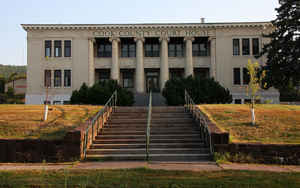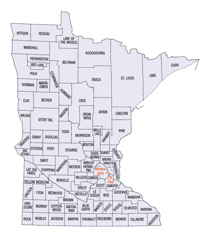Minnesota Counties
There are eighty-seven Counties in Minnesota. On October 27, 1849 nine large Minnesota Counties were created. Among them were Benton, Dahkotah, Itasca, Ramsey, Mahkahta, Pembina, Wabashaw, Washington, and Wahnata. Of those Benton, Dakota, Itasca, Ramsey, Wabasha, and Washington still exist as their original name. With the creation of Kittson County on March 9, 1878, Pembina County no longer existed. When Minnesota was organized as a state, 57 of the present 87 Counties were established. The last county to be created was Lake of the Woods County in 1923Cook County, Minnesota
Cook County Education, Geography, and History
Cook County is a county located in the state of Minnesota. Based on the 2010 census, the population was 5,176, making it the fifth-least populous county in Minnesota. Its county seat is Grand Marais. The Grand Portage Indian Reservation is entirely within the county.
Etymology - Origin of County Name
Named for Major Michael Cook of Faribault. Territorial and state senator, 1857-62; killed in Civil War at battle of Nashville
Demographics:
County QuickFacts: CensusBureau Quick Facts
Cook County History
This county, established March 9, 1874, was named in honor of Major Michael Cook, of Faribault, a prominent citizen and
a brave soldier in the civil war. He was born in Morris county, N. J., March 17, 1828; came to Minnesota, settling in Faribault, in 1855, and
being a carpenter, aided in building some of the first frame houses there; and was a territorial and state senator, 1857 to 1862. In
September, 1862, he was mustered into the Tenth Minnesota regiment, in which he was appointed major, and served until he fell mortally wounded
in the battle of Nashville, December 16, 1864, his death occurring eleven days later.
Colonel Charles H. Graves, the state senator from Duluth, introduced the bill to establish this county and to name it in honor of Verendrye,
the pioneer of exploration on the northern boundary of Minnesota; but the name was changed before the bill was enacted as a law. It has been
thought by some that the name adopted was in commemoration of John Cook, who was killed by Ojibway Indians, as also his entire family, in
1872, his house at Audubon, Minn., being burned to conceal the deed. Colonel Graves has stated, in a letter, that this name was selected to
honor Major Cook.
It may well be hoped that some county, yet to be formed adjoining the north line of Minnesota, will receive the name Verendrye, in historic
commemoration of the explorations, hardships, and sacrifices of this patriotic and truly noble French explorer. He was the founder of the fur
trade in northern Minnesota, in Manitoba, and the Saskatchewan region, where it greatly flourished during the next hundred years; and two of
his sons were the first white men to see the Rocky mountains, or at least some eastern range or outpost group of the great Cordilleran
mountain belt.
Geography: Land and Water
Eagle Mountain, the highest natural point in Minnesota at 2,301 feet (701 m), is located in northern Cook County.
As reported by the Census Bureau, the county has a total area of 3,340 square miles (8,700 km2), of which 1,452 square miles (3,760 km2) is
land and 1,887 square miles (4,890 km2) (57%) is water.
It is the second-largest county in Minnesota by total area. The highest natural point in Minnesota, Eagle Mountain at 2,301 feet (701 m), and
the highest lake in Minnesota, Lake Abita at 2,048 feet (624 m), are located in Cook County. Lake Superior is at the county's southern border.
Neighboring Counties
Bordering counties are as follows:
- Rainy River District, Ontario Canada (northwest)
- Thunder Bay District, Ontario Canada (northeast/EST Border east of the 90th meridian west)
- Lake County, Minnesota (west)
- Ashland County, Wisconsin (south)
- Keweenaw County, Michigan (east/EST Border)
- Ontonagon County, Michigan (southeast/EST Border)
Education







